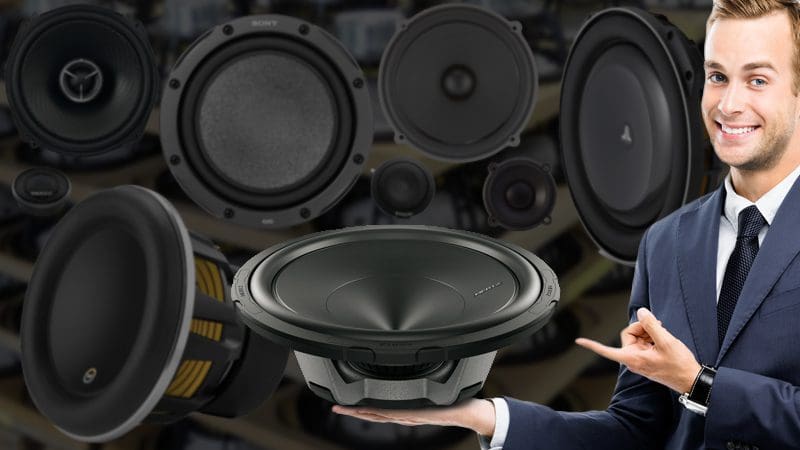 When you head to your local mobile electronics specialist in search of new speakers, there are a few criteria to keep in mind. Choosing a speaker size can go one of two ways: You can pick something that fits a specific mounting location or you can choose based on the characteristics of the speaker relative to its size. Are you interested in knowing why speakers come in different sizes? Good! You’ve come to the right place.
When you head to your local mobile electronics specialist in search of new speakers, there are a few criteria to keep in mind. Choosing a speaker size can go one of two ways: You can pick something that fits a specific mounting location or you can choose based on the characteristics of the speaker relative to its size. Are you interested in knowing why speakers come in different sizes? Good! You’ve come to the right place.
What Does a Speaker Do?
It is the job of a speaker to convert the electrical signal from your amplifier into motion. The motion of the speaker cone excites the air around it. As the cone moves forward, the air in front of the cone is pressurized. As the cone moves rearward, the air is rarefied. These pressure waves extend out from the speaker and our ears detect these minute changes in pressure as sound. Pretty simple, isn’t it?
Things to Consider in Terms of Reproducing Sound
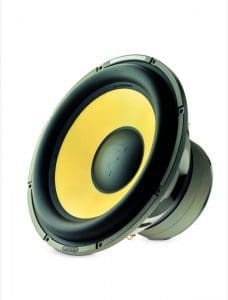 When it comes to reproducing sounds, the lower the frequency, the harder it is to produce the sound. For every doubling of frequency, the speaker cone has to move a quarter the distance to produce the same level of output. As example, if your subwoofer has to move 2 mm to produce 95 dB of output and 40 Hz, it only has to move 0.5 mm to reproduce 95 dB at 80 Hz. To reproduce 95 dB of output at 160 Hz, the cone only has to move 0.125 mm.
When it comes to reproducing sounds, the lower the frequency, the harder it is to produce the sound. For every doubling of frequency, the speaker cone has to move a quarter the distance to produce the same level of output. As example, if your subwoofer has to move 2 mm to produce 95 dB of output and 40 Hz, it only has to move 0.5 mm to reproduce 95 dB at 80 Hz. To reproduce 95 dB of output at 160 Hz, the cone only has to move 0.125 mm.
The size of a speaker cone affects how much sound the speaker will create for a given amount of input signal. Let’s generalize things a little (because a lot of external factors affect this statement): A 12-inch speaker cone has to move twice as far as a 15-inch speaker cone to produce the same amount of output at a given frequency. That also means the 12-inch speaker requires more power to produce the same sound as the 15-inch.
Bigger is Always Better, Right?
Based on this logic, you should simply select the biggest possible speaker for every application, right? Well, it’s not quite that easy. When we get into midrange and high frequencies, the speaker cone has to move back and forth very fast. A 1,000 Hz tone requires that the speaker move forward and backward 1,000 times a second. A 10 kHz tone requires 10,000 of these same motions per second. If we use a big speaker with a relatively heavy cone, it’s very hard to keep up with the input signal. Why? Inertia.
 Let’s use an analogy to help explain this. Imagine that you are at a parade and waving a flag. The pole is 6 feet long and the flag on the end is 3×5-foot. You wave the flag back and forth as fast as you can. Even if you are really strong, the fastest you can wave it back and forth is once, maybe twice a second. Now, look at the little kid standing beside you at the parade. He has a little paper flag that’s 2×3 inches on a 5-inch-long plastic stick. His little hands can wave that flag back and forth five or six times a second.
Let’s use an analogy to help explain this. Imagine that you are at a parade and waving a flag. The pole is 6 feet long and the flag on the end is 3×5-foot. You wave the flag back and forth as fast as you can. Even if you are really strong, the fastest you can wave it back and forth is once, maybe twice a second. Now, look at the little kid standing beside you at the parade. He has a little paper flag that’s 2×3 inches on a 5-inch-long plastic stick. His little hands can wave that flag back and forth five or six times a second.
Speaker engineers have to balance several characteristics to achieve specific goals for a given design. Let’s compare the weight of a speaker cone for a 10-inch subwoofer to that of a 10-inch midrange used in concerts and public address systems. A typical 10-inch sub that is designed to play frequencies below 150 Hz has a cone assembly (cone, voice coil, former, half the spider and half the surround) that weighs around 150 grams. A 10-inch speaker designed to be used for midrange frequencies (150 to 1 kHz) has a cone mass assembly of around 40 grams.
Clearly, the lighter assembly can move faster and keep up with the reproduction of higher frequencies.
Is Lighter Better?
Now we face the conundrum of balancing low- vs. high-frequency output. A lighter cone will move faster and is capable of producing extended high-frequency output. A heavier cone has a lower resonant frequency and thus, can produce more low-frequency output. Combine these generalizations with electrical issues affecting voice coil inductance, and we further hinder high-frequency output. It starts to become clear that we need different-sized speakers for different applications.
Subwoofers
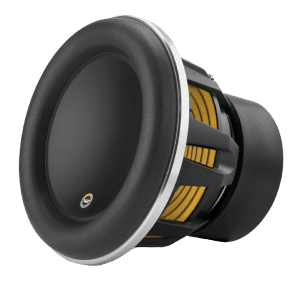 Most subwoofers are sized from 8 to 18 inches. Since subwoofers are designed to play frequencies below 100 Hz in car audio applications, they need a lot of excursion capability and a low resonant frequency. This means subwoofers will have relatively heavy cones. At high excursion levels, cones are exposed to significant stresses, so the cone has to be strong, and this further contributes to their weight. Subwoofers have to handle a lot of power. This power allows us to move the cone over relatively large distances. Power handling requires bigger components in the form of large-diameter voice-coil formers and windings.
Most subwoofers are sized from 8 to 18 inches. Since subwoofers are designed to play frequencies below 100 Hz in car audio applications, they need a lot of excursion capability and a low resonant frequency. This means subwoofers will have relatively heavy cones. At high excursion levels, cones are exposed to significant stresses, so the cone has to be strong, and this further contributes to their weight. Subwoofers have to handle a lot of power. This power allows us to move the cone over relatively large distances. Power handling requires bigger components in the form of large-diameter voice-coil formers and windings.
Midbass Drivers
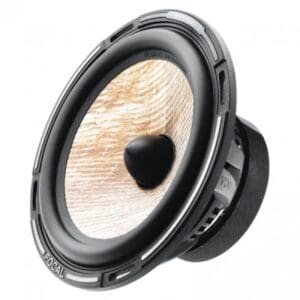 A dedicated midbass driver is typically designed to play from around 50 to 500 Hz. Sizes are typically 6.5 to 8 inches in size, but some people have used 10- and 12-inch drivers. The cone has to be heavier than that of a midrange, but not heavy enough to slow it down for higher frequencies.
A dedicated midbass driver is typically designed to play from around 50 to 500 Hz. Sizes are typically 6.5 to 8 inches in size, but some people have used 10- and 12-inch drivers. The cone has to be heavier than that of a midrange, but not heavy enough to slow it down for higher frequencies.
If you look at the frequency content of a performer, you will see that many voices extend down to 100 Hz. Accuracy in speed is important in this frequency range. Resonances and non-linear behavior causes harmonic distortion. This is often perceived as “warmth” in the midbass region. We do not want anything extra in our music, so accuracy is what matters.
Midrange Speakers
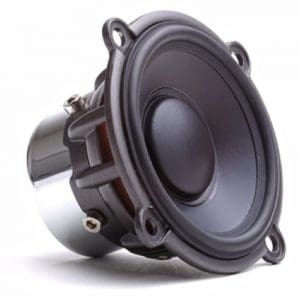 Midrange speakers become a balancing act of several different characteristics. Of course, the cone has to be relatively light, but managing linearity and distortion becomes an even higher priority. It’s easier to hear distortion at midrange frequencies. The cone has to balance mass, damping and strength to prevent deforming and cause harmonics. The suspension has to be very linear.
Midrange speakers become a balancing act of several different characteristics. Of course, the cone has to be relatively light, but managing linearity and distortion becomes an even higher priority. It’s easier to hear distortion at midrange frequencies. The cone has to balance mass, damping and strength to prevent deforming and cause harmonics. The suspension has to be very linear.
Managing inductance also becomes a more significant issue because it can reduce high frequency output. Midrange drivers for typical car audio applications vary in size from 6.5 inches and 6×9 inches on the large side down to as small as 2.5 inches. Many midrange drivers try to do double-duty as midbass drivers for use in two- or three-way audio systems. While this is a minor compromise, it is a necessity. We consider midrange speakers to cover the range from 100 Hz to 3,000 or 4,000 Hz.
Tweeters
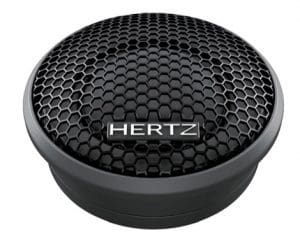 To reproduce frequencies above 2.5 kHz, tweeters need very light cones. Tweeter cones don’t move very far, so they don’t require much excursion, but there still has to be a suspension. Resonances in the cone can wreak havoc with frequency response. Premium tweeters may make use of features like ferrofluid in the gap to improve power handling. Premium tweeters may also include a copper pole-piece cap to reduce inductance and distortion.
To reproduce frequencies above 2.5 kHz, tweeters need very light cones. Tweeter cones don’t move very far, so they don’t require much excursion, but there still has to be a suspension. Resonances in the cone can wreak havoc with frequency response. Premium tweeters may make use of features like ferrofluid in the gap to improve power handling. Premium tweeters may also include a copper pole-piece cap to reduce inductance and distortion.
Directivity Considerations
Another consideration when choosing speakers is that all speakers above a certain frequency start to become directional. Directivity refers to a reduction in high-frequency output as you move off-axis to the speaker. If you choose your speakers and design your system carefully, you can minimize the effect of directivity. The only real consideration would be to have your tweeters pointed at you.
The Balancing Act
The applications for the information in this article vary, depending on your overall goal for your audio system upgrade. A simple set of coaxial replacement speakers will be chosen by the size application. If you are building a high-end audio system with multiple amplifiers, channels, digital signal processing and custom speaker mounting locations, then choosing the right speakers in terms of their quality and intended application becomes more important.
Learn More about Speakers and Their Different Sizes at Your Local Retailer
Your local mobile electronics specialist retailer can help you choose the right speakers for your application and performance goals. Drop in at a local shop today and have a listen to their demo board or demo vehicle. It’s an amazing experience!
This article is written and produced by the team at www.BestCarAudio.com. Reproduction or use of any kind is prohibited without the express written permission of 1sixty8 media.
